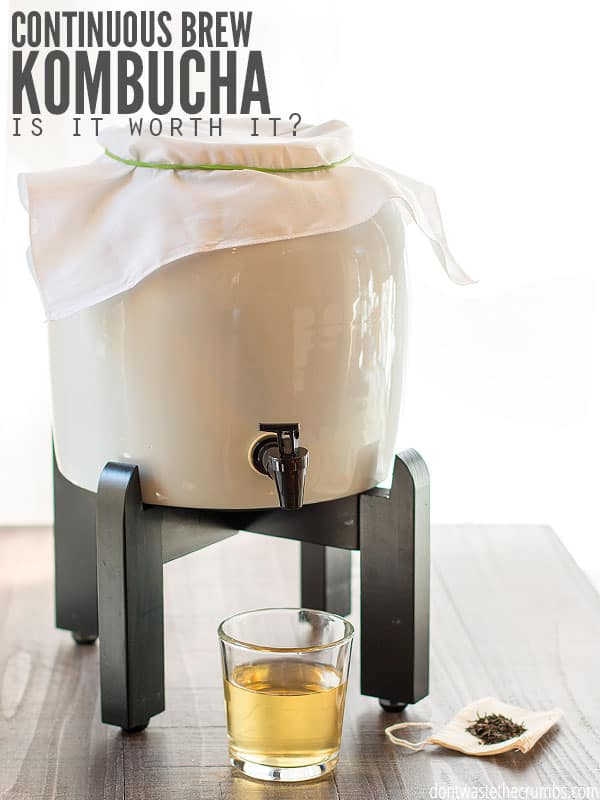
Earlier this summer I piecemealed together a DIY kombucha kit so that I could save money by not buying kombucha from the store anymore.
I had originally considered a kombucha continuous brew system, but wasn’t sure how I felt about the price tag. I mean, $300 is a lot of money!
Plus I was new to brewing kombucha in the first place. How was I to know if a kombucha continuous brew system was worth it, or just a big waste of money?
Before I keep going, let’s back up for a second. For years I’ve been sharing ways to wisely steward your finances by saving money on real food. Although the term most often used is “frugal,” I’m not sure it’s accurate.
True, I try not to spend money if I don’t have to and I’m likely to do things myself versus paying for convenience – hence the reason for scraping together pickle jars, nut milk bags and tea balls from garage sales over the course of four months just to make fermented tea – but I also believe in paying for quality.
Perfect example – I own a Blendtec high powered blender. I also own a KitchenAid Artisan Stand Mixer. Both are on the high end for kitchen appliances and both can be easily replaced with items that cost less. However, I bought each one because of the quality and reputation.
I would rather spend more money up front for something that will last practically forever, than spend less money on something I will have to replace later on. And for some things, there’s a good chance I would have had to replace it multiple times. Which to me, defeats the purpose of spending less money in the first place.
Along this line of thinking, food quality is also something that is important to me. But our frugal budget doesn’t always allow for all organic produce or all pastured meats. I go over the process of evaluating food priorities in Grocery Budget Bootcamp (Enrollment is currently closed, but you can join my FREE 5-day Crush Inflation Challenge and start saving money on groceries tomorrow!). These thoughts can be applied to quality kitchen appliances too.
Back to the kombucha continuous brew kit. I didn’t buy one for two main reasons:
- They’re on the expensive side. What if I was able to brew kombucha without a kit just fine? Would I then regret spending the money on the continuous brew kit?
- I was BRAND NEW to making kombucha in the first place. What if I brewed kombucha for two weeks and then decided it wasn’t for me. Would the continuous brew kit have been a waste of money?
Not too long after I mastered the DIY version of making kombucha, I was given the opportunity to review a kombucha continuous brew kit from GetKombucha. Figuring you guys probably have the same hesitations and questions that I did, I said yes. Here are my honest thoughts on a kombucha continuous brew kit.
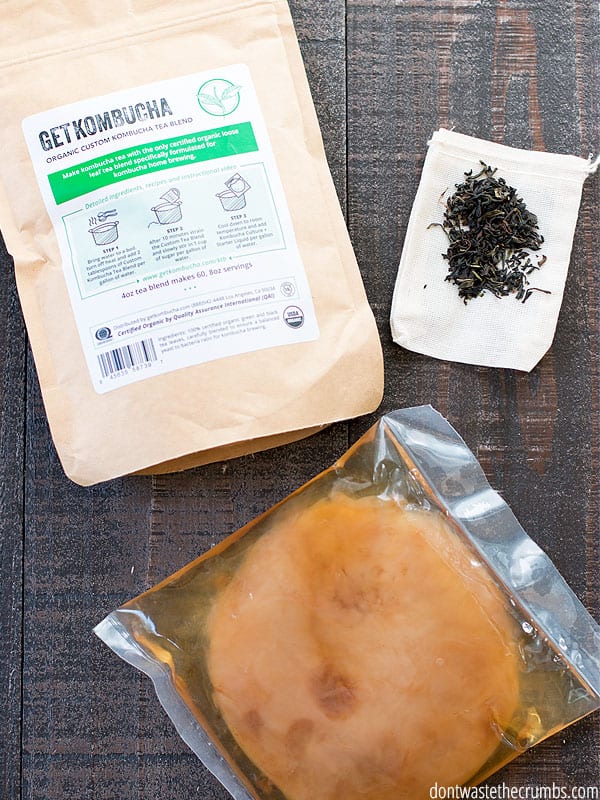
Pros to a Kombucha Continuous Brew Kit
Everything you need is in the box.
You could say that this is the whole point of buying the kit, but considering it took me 4 months to scavenge everything together to brew (tea balls, milk bags, tea, sugar, rubber bands, pH strips, scoby and starter tea), being able to open one single box with everything inside is a HUGE plus.
I especially appreciated having both tea and a scoby in the box. I don’t think any proper kombucha continuous brew kit would exclude them, but these two items are the hardest to source (in my opinion), so not having to think about where to find those ON TOP OF all the other little things you need to brew kombucha is really nice.
A 2 ½ gallon ceramic brewer.
Finding a container that is ready to go (as in you DON’T have to eat a gallon of pickles first) is not easy. I love that the kit not only comes with a brewer, but that it’s over twice the size of the biggest glass jar I could find.
The brewer stand.
With my bootstrap method, I kept the jar on a napkin (to catch any drips) and pulled the jar to the edge of the counter to dispense. When I was done, I pushed it back so that kids running through the kitchen (or mom cooking dinner) wouldn’t get their shirts caught on the nozzle, effectively pulling down and shattering the glass jar and freshly batched kombucha with it.
The brewer stand lets me store the kombucha on the back of the counter, fitting just fine under my kitchen cabinets. When I want a glass, I just stick it under the spout and fill up!
Quick start instructions.
Get Kombucha includes a cute comic-strip like instruction guide, which makes it SUPER easy to get started. I learned something new, even though I’ve been brewing for several months!
Extra tea, extra sugar, extra scoby and flavor boosters.
Whether you get these fun extras depends on what type of kombucha continuous brew kit you choose.
The Basic Edition set comes with everything I’ve mentioned so far, but does NOT include an extra bag of tea, sugar or flavor booster.
The Premium Edition comes with everything above AND the extra tea, sugar, scoby and flavor boosters. I personally haven’t used the extra scoby yet, but it’s nice to have in case mine dies or if I want to give it as a gift to a friend.
The Brewmaster Select Edition comes with everything above AND the extra tea, sugar, scoby and flavor boosters AND also includes:
- pH strips
- digital pH tester
- heater mat (so you can brew regardless of how cold your kitchen is!)
- 4 kombucha tinctures (extract, probiotic concentrate, tonic drops and facial toner)
Here is a kombucha continuous brew jar or this one. Just make sure to keep it out of direct sunlight.
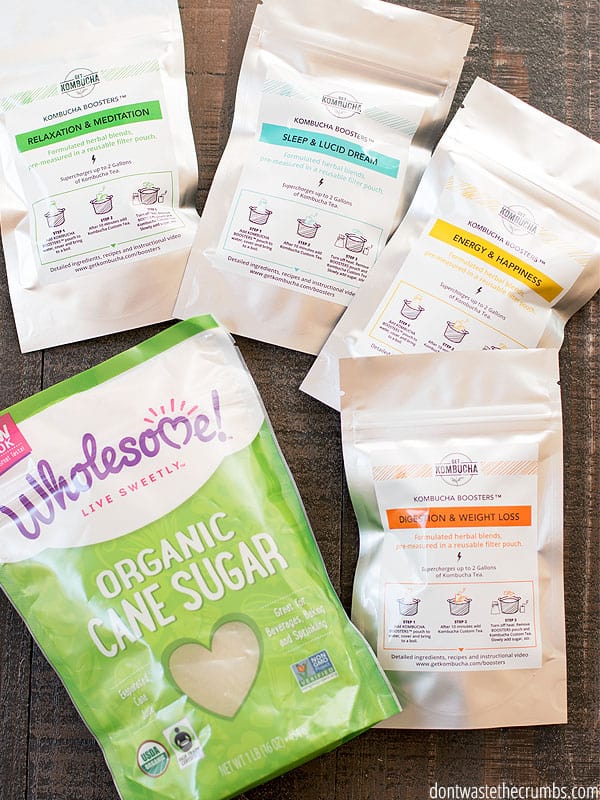
Cons to a Kombucha Continuous Brew Kit
The cost.
After lots of consideration, my only con to a continuous brew kit is the cost. It’s hard to justify a large expense when you know you can do it yourself for less, BUT there is something to be said for the convenience factor.
My scoby sat on my counter for 4 months because I didn’t have everything else I needed to brew. If I was buying kombucha while I waited, I would have been wasting tons of money.
Say for example the average 16 oz bottle of kombucha costs $3 and you buy 5 bottles each week. That’s $15. At this rate, you’ll have paid for the The Basic Edition continuous brew kit in just 3 months.
The savings add up quicker if you drink more kombucha or have several members in the family who drink it. I personally drink 16 oz every day and my husband drinks about 24 oz each week. That’s 11 1/2 bottles at $3 each for a total cost of $34.50 each week. We would hit the threshold for The Basic Edition kit in less than 6 weeks!!
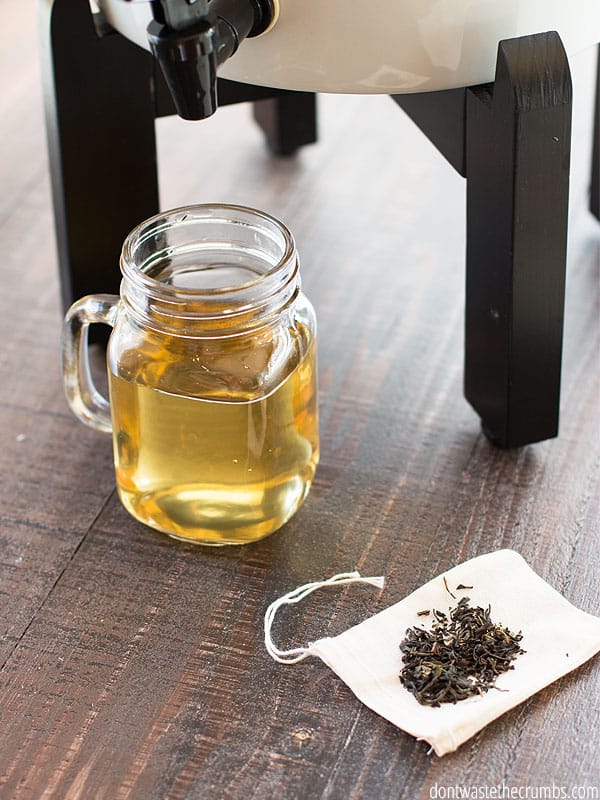
Which kit is right for you?
I’ve experimented with both ends of the kombucha brewing spectrum, from the DIY bootstrap version all the way up to The Brewmaster Select edition of kombucha continuous brew kits. Here’s how to decide which kit is right for you.
Choose the DIY bootstrap version if you:
- don’t have the funds for an entire kit but do have some funds to piecemeal it together over time
- prefer the thrill of the hunt to find the pieces needed to make your own kit
- really like pickles (I’m not joking when I say one gallon of pickles is A LOT)
To get started with the DIY bootstrap version, use this kombucha recipe tutorial.
Choose a kombucha continuous brew kit if you:
- already drink a lot of kombucha (i.e. 16 oz several times a week yourself and/or combined household)
- prefer the convenience of having everything ready to go for you in one box
- have always wanted to brew kombucha but feel overwhelmed at the idea of putting together your own kit
Choose a mix between a full brew kit and DIY if you:
- like the idea of a kit, but don’t want to pay quite so much
My solution for those who don’t want to DIY all the pieces but don’t want to buy the fancy set, is to get this starter kit and this brewing jar.
Which is best for you?
After using my bootstrap version for several months and then testing out the kombucha continuous brew kit, I have to admit that I’ve put away my gallon glass jars and my pretty spout from ALDI and have officially converted to the kombucha continuous brew kit. Using the ceramic jug on the stand is incredibly easy and convenient. Plus now I can make a new batch just a hair bit less often, or share willingly with my friends when they come over (without worrying about running out!).
When I make more tea, I make 1 1/2 gallons in a big stock pot and when it’s cool, I dump it into the ceramic jug. No more moving the scoby around and dirtying several dishes in the process. I now dirty just the stock pot and silicone tongs (to remove the tea) and call it done!
Do you like a second ferment and fizzy kombucha?? Try these recipes:





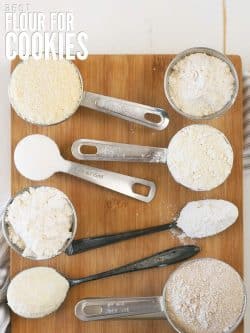

brewing kombucha doesn’t need to cost a lot. Buy a scoby or get one from someone. i have a vessel with a spigot and cost me $40. my swingtop bottles cost me $3.
Not expensive at all, under $60
I’m a recovered alcoholic. We have a local source for non-alcoholic kombucha that I just can’t afford. I’m wondering about homemade. Is it going to have alcohol? I’m only just getting into fermentation. Love, love the flavor of all things fermented.
I believe the resulting level of alcohol in store-bought kombucha is around .5%, but I’m not sure about homemade. I hope that helps Heidi!
Thanks!
It is your vinager, but I understand. Many different scobys! What is your position on water kefir?
Ah – ACV! Thanks for the clarification. I think water kefir is a great non-dairy option. I haven’t made it personally, but I would if I had the grains. The more probiotics, the better!
Hi, me again. As you are the master I have another question. I made okra pickles, put them in the fridge, and now I decided I want them more sour. Can I just restart the ferment with the same pickles?
I appreciate the compliment, but I’m far from the master of ferments! Have you checked out traditionalcookingschool.com? My friend Wardee is VERY experienced at all sorts of ferments. My skills pretty much stop at kombucha. 🙂
I will check that. You got me this far and I appreciate it!
You’re very welcome!
Can I use the scoby from the vinager I made for this recipe?
Probably not Mark. I’m not sure what vinegar you made, but a kombucha scoby is not the same thing as the healthy bacteria from vinegar.
BTW, thank you for your response, and so prompt!
I’ve never had a problem getting a scoby to form. I even used Gingerade the last time, and my scoby is strong, after just 2 go-rounds. Although it certainly looks nifty, I can’t see any reason to purchase such a “system.” I’ve had great success, and when my scoby gets too big I chop some up and give it to my friend for her chickens. They love it, and then I get free eggs. I also use Newman’s organic black tea bags (because that’s what we like) which I have an Amazon subscription for. I’ve been brewing for a couple of years, and I didn’t find it difficult at all to gather the necessary items. I use kitchen twine instead of rubber bands. I reuse original Kombucha bottles, and I scored a case of swing-top bottles at auction.
I got a glass pick-nick jug with the spigot at the bottom, with a coffee filter and rubber band top. The Scoby was created by using store bought Kombucha and waiting for the scoby to appear. All this cost $3.50 for the Kombucha scoby, $4.95 for the jug, a few dollars a month for the sugar, minimal cents for the rubber bands and coffee filter, and the tea cost whatever you would pay for tea. I use Yerba Mata sometimes, or just plain black tea other times. So, it is not that expensive to set up a kombucha continuous brew system. There is really no reason to pay money for something that can be so cheap to make.
You do make a good point Katy, in that you can make it yourself (which I did here: https://dontwastethecrumbs.com/2016/09/kombucha-recipe/). The kink in the system is waiting for a scoby to appear from store-bought (if it ever does), finding a jar for a good price and a quality tea. For some, they don’t have time or patience to acquire these things. And I have received many compliments on the ceramic jar you see in this picture. 🙂
Hi Tiffany
Do you know where i can find de dispenser, and what size is ??
Regards
Jose
Hi Jose – this 2 1/2 gallon ceramic dispenser comes with the kombucha kit. You can buy it here: https://dontwastethecrumbs.com/go/kombucharecipeguide/
I share your love of a continuous brew system, but I did struggle with the cost. For quite a while this summer, our local Walmart carried 2 gallon glass tea jars, and the $15 I paid for this jar was money well spent. I also purchased some of the Sparkling Lemonade from Aldi’s, that comes in the large flip Top bottles, and all together I managed to set up a very basic continuous brew system for $30. There were still lots of giant jars left at my Walmart in the clearance section, and there might be some in other Walmart’s as well.
We’ve gotten so hooked on my super fizzy second ferment flavors, that I’ve never really given continuous brew much thought. But, duh – I guess I could fill my swing top bottles from the spout! My only question is the flavor – do you find that your brew gets any more vinegary/acidic in the continuous system?
Hi Dena! Yes – fill the bottles straight from the tap! My opinion might be skewed here, because I started the system with what came in the box and in my one box of scoby there were actually TWO scobys. I added both to the pot, so my brew gets more acidic faster because of them when I only brew one gallon. If I brew two gallons, it’s back to the regular balance. The easy fix though is to take one scoby out if it brews too fast. As for the acidity in the continuous brew system alone, I haven’t noticed any significant increase!
I did continuous brew for awhile, and I liked the convenience of adding/dispensing tea whenever I wanted, but I went back to the batch brewing method because I like the flavor so much more. With the continuous brew, my kombucha would get acidic and strong so fast, and it hurt my tummy.
By the way, my favorite tea to brew with the last several months has been a loose leaf black with rose petals. Oh my goodness, sooo good! It doesn’t need a second ferment
Thanks for sharing Heather! I tried the “health and recovery” blend from Get Kombucha and it had echinacea, currants, elderberries, cranberries, rose hips and hibiscus and it was SO good! I think I might take a look at adding some of that to my loose leaf blend. 🙂
Is the main benefit of the “system” then the larger ceramic jar and stand?
We like our kombucha cold, so I’m wondering if there is a huge advantage to the continuous brew system. I have a lemonade/pickle jar with a spout already attached that will fit into the fridge. I doubt the 2 1/2 gallon container could fit.
When I started making kombucha as a teenager, I just bought a SCOBY off Ebay for $5.00. I also bought some cheap black and green tea bags, but we already had sugar, a one gallon jar and cheesecloth. If I remember correctly, the Nourishing Traditions cookbook said that using plain white sugar was okay. No PH strips or tea balls involved. I had less than $10.00 invested into my “system” with no garage sale scrounging required.
I guess I’m a little confused at how a continuous brew system is any different than regular brewing apart from the larger container. One of my friends recently started making kombucha. She uses expensive natural sugars, bought a bunch of swing-top bottles, does a secondary ferment, etc., etc. I guess it’s cheaper than buying kombucha, but I was left scratching my head wondering if the fancy ingredients and extra equipment is really worth the money!!
That’s one of the benefits Bethany, but so is the ability to add sweetened tea to the jar and not have to mess with moving scobys around and reserving liquid and stuff. Since you handle the scoby less, it gets stronger and brews better over time. There’s also the cleanliness factor, where by being in the jar less and handling the scoby less, instances of contamination go down.
You’re lucky to already have some of the supplies needed to brew kombucha! I didn’t have anything – zip – so I was literally starting from scratch.
You can use plain white sugar and you can do a second ferment with swing top bottles (I do) and even if you go high end, it’s still more affordable than buying kombucha to support your drinking habit. 😉 In the end, it comes down to convenience, what you already have on hand and how much work you’re willing to put into setting up your own system. For some, it’s entirely worth it. For others, it’s not. 🙂
Totally agree with all your points. My mum and I started brewing kombucha over 30 years ago. There were always heaps of scobies hanging about the fridge in ‘scoby hotels’. I make a batch every week just about. My jars are large flip-top glass jars from the supermarket – $4. I like using Rooibos tea and Green tea, I use white sugar because the scoby eats it a whole lot easier. It sits on my benchtop with some cheesecloth over it for a week and then I put the kombucha in smaller bottles in the fridge (I like mine cold). I don’t bother with a second ferment. You can stick a vanilla pod in one of the bottles in the fridge and it tastes like creamy soda – yum.
Every time you make a batch – you get a new scoby. I have so many that I put them in the compost. I give them away to anybody who wants one, and usually give them two.
I can’t see the sense in paying out $300 for an ‘Artisan’ kit when I’m making mine for about $2 a batch – but that’s just my take on it. Maybe if I got myself a man-bun and a full-sleeve tattoo I would require a fancy kit to match ….
I Found a 21/2 gallon Crock w/stand on E-bay.. Not to Expensive, got my Own Scoby , started from store bought Kombucha, Easy , and ” Very Frugal”